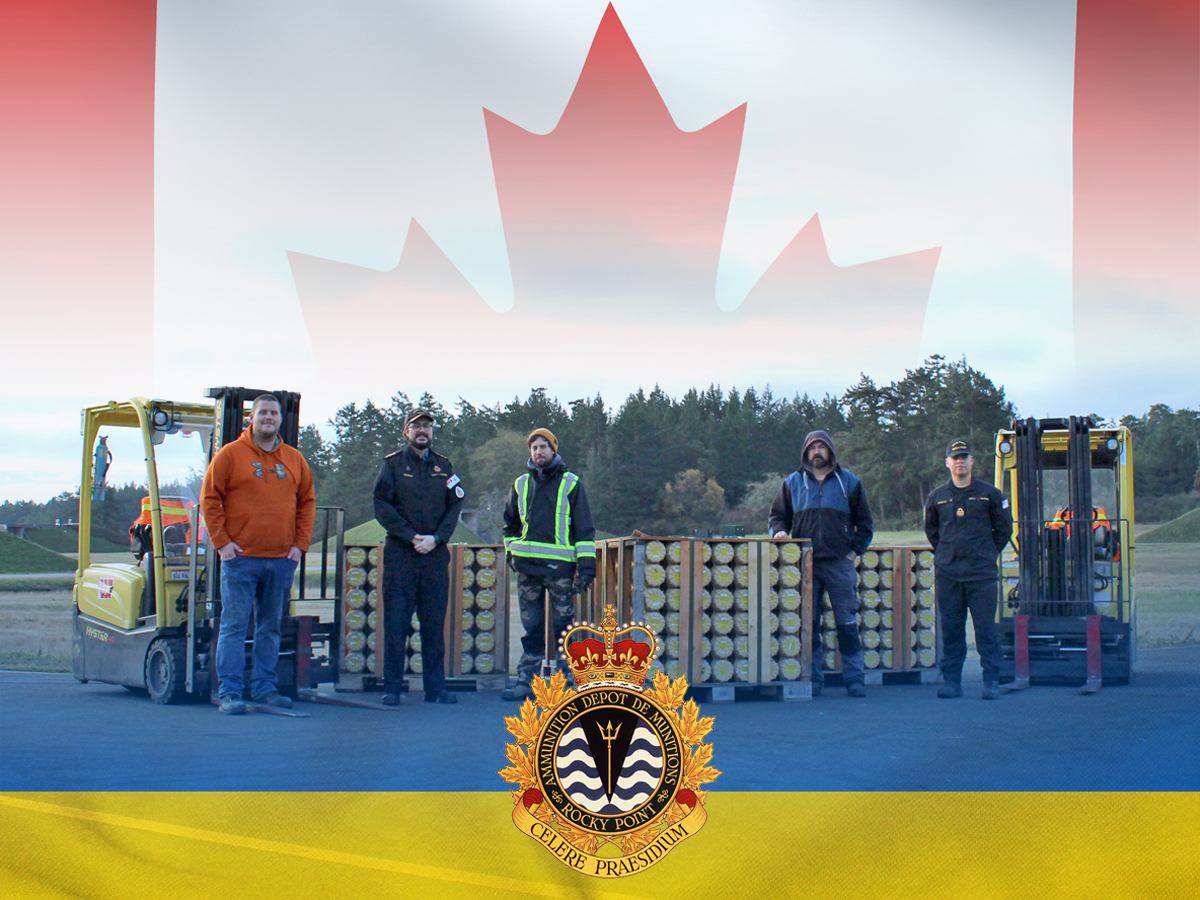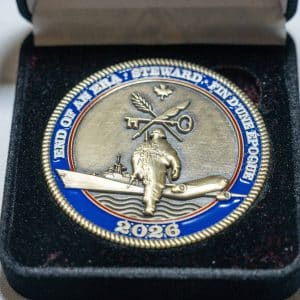
Kateryna Bandura,
Lookout Editor
—
Wooden pallets sit amid 26 ammunition magazines on a chilly November morning at Canadian Forces Ammunition Depot (CFAD) Rocky Point near Metchosin.
Each pallet contains 42 rounds of 76-millimetre naval ammunition waiting to be loaded on an unmarked military 18-wheeler to make their way to Bedford, N.S. There, the Canadian Materiel Support Group will pool it with donations from CFADs across Canada (Dundurn, Angus, Bedford).
The ammunition is destined for the Armed Forces of Ukraine (AFU). Officials in Ottawa decide the type of requested equipment; where the equipment will end up is up to the Ukrainian officials.
This is the first donation to Ukraine by the Rocky Point Depot. Lieutenant-Commander (LCdr) Craig Newman, CFAD Rocky Point Commanding Officer, says the Depot is very proud to participate and support Ukraine.
“This donation is a demonstration of the continued support that Canada has for Ukraine,” LCdr Newman said. “Making contributions where and when we can with what we have to offer is, no doubt, a meaningful demonstration of that support to our allies.”
The ammunition has been residing at CFAD Rocky Point since 2015, when HMCS Algonquin, the last Iroquois-class destroyer that used this type of ammunition, was paid off.
The current fleet of Halifax-class frigates employs a different kind of ammunition, making the 76-millimetre surplus to requirements.
The strict ammunition safety program with the Department of National Defence ensures that stored ammunition remains serviceable, even if it’s been stowed away for almost a decade.
A Lifecycle Materiel Manager (LCMM) is assigned to every piece of military equipment and is responsible for the ‘cradle-to-grave’ care from procurement until disposal. The LCMM assigned to the 76-millimetre gun ammunition had yet to decide on the course of action to dispose of the items.
“A donation is certainly an exceptional way to dispose of military equipment,” LCdr Newman says. “I’m certain we would not donate something that wouldn’t be of use to them.”
The conditions inside each magazine storage at CFAD Rocky Point help keep the ammunition safe and dry at up to 25°C, and measures have been put in place to prevent moisture, corrosion, and pests.
Besides undergoing the required periodic inspections, the 76-millimeter ammunition has been inspected again in preparation for issues to Ukraine. During issue inspections, all required ammunition is brought to the Transit Facility that doubles as an explosives workshop, which permits unboxing activities.
“We inspect it twice, which is our quality assurance method,” LCdr Newman says.
While the ammunition technicians move the pallets out of the magazine, Jason Roberts, Civilian Ammunition Technician Supervisor, visually inspects the pallets.
“We’ve checked all the pallets individually over the past week, so we already know what goes on board,” he says. “Now, we ensure the safety and security of the items. Other than that, this is just another shipment.”
Roberts ensures the Depot complies with all policies associated with moving ammunition and explosives under the Transportation of Dangerous Goods Act and signs off on the final paperwork.
The pallets are stacked next to each other very tightly in the back of the truck, horizontally as opposed to on top of each other, which would require two-by-fours to brace the load up hills and around tight curves. From here, the truck will board the dangerous goods ferry in Sidney and the drivers will drive non-stop from Vancouver all the way to Bedford.
Once the staff at Bedford receive the ammunition, they will let Rocky Point know the donation has reached its destination.
Now that there is 25 per cent more free space in the storage magazine, LCdr Newman says the Depot is preparing for the anticipated ammunition and explosives storage requirements of the future Canadian Surface Combatant.
The Depot has a very small group of skilled ammunition technicians and ship repair technicians responsible for ammunition, not just with the Royal Canadian Navy but also with the Army and Air Force.
“It is a point of pride for our ammunition technicians, to see their effort help Armed Forces achieve operational success, whether on exercise in the United States or halfway around the world,” LCdr Newman said.








